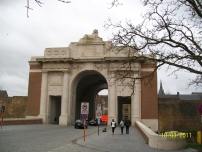| First Name: | William Walter | Last Name: | HUTTON | |
|---|---|---|---|---|
| Date of Death: | 21/10/1914 | Lived/Born In: | Dalston | |
| Rank: | Private | Unit: | Worcestershire2 | |
| Memorial Site: | Menin Gate, Ypres | |||
Current Information:Age-26 52, Barnsbury Street, Upper Street, Islington
First Battle of Ypres Between 21st October and 22nd November, 1914 a desperate fight took place around the Belgium city of Ypres, the first of three major battles that were to be fought there during the course of the war. British troops entered Ypres in October. The 1st and 2nd Divisions plus the 3rd Cavalry Division had made their way up from the Aisne as part of the “Race to the Sea”, whilst the 7th Division came west to Ypres after Antwerp had fallen. The Germans knew that Ypres was the gateway to the Channel ports and that these were vital to Britain’s war effort so they poured reinforcements into the area. The fighting fell into three distinct battles; the Battle of Langemarck, 21-24 October, the Battle of Gheluvelt, 29-31 October and the Battle of Nonne Bosschen, 11 November. Ypres did not fall to the Germans but its defence during these two months resulted in the destruction of much of the old regular British Army. I Corps orders for 21st October were for an advance in two stages the first to a line running from Passchendaele to Poelcappelle then to a line 1½ miles further north through Westroosebeke. Congestion on the roads meant that 1st Division did not reach the starting line at Langemarck until 8.30am by which time 2nd Division had its leading troops on the Zonnebeke-Langemarck road with Divisional HQ at St Julien. 5 Brigade, including the 2nd Worcestershire battalion were on the left in the Steenbeek depression one mile north of St Julien and when units of 1st Division came up on their left at 9.20am, the advance began. Steady progress made at first but heavy German fire was met when the Zonnebeke-Langemarck road was crossed. The Germans were greatly assisted by the many streams and thick hedges which obscured the view of the advancing British. The German fire was not too accurate except near St Julien where, 2nd Worcestershire suffered most of their casualties that day from oblique machine gun and rifle fire. By 2 pm the general line had been advanced 1000-2000 yards from the Zonnebeke-Langmarck road and was close to the main German line but later they were forced to cede ground. One of their many casualties was William Hutton. |
||||
| « Back to Search Results | ||||
| If you think any of the information shown here is incorrect, Click Here to submit your amends and comments | ||||




